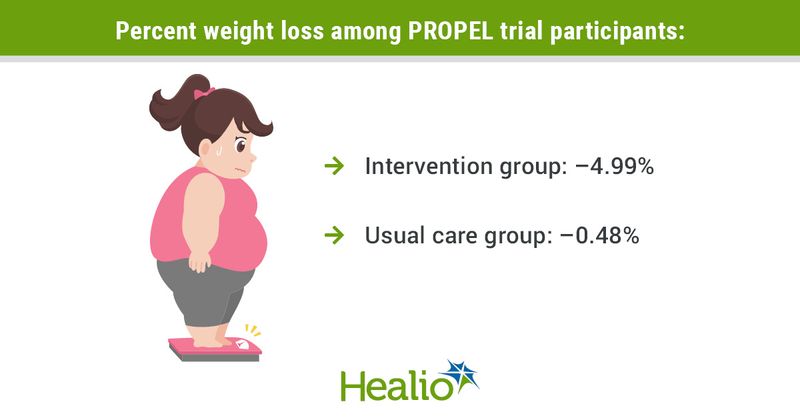PROPEL trial: Primary care intervention helps low-income populations lose weight
An intervention geared toward low-income patients in the primary care setting helped the participants lose weight, according to results from a randomized trial published in The New England Journal of Medicine.
The Promoting Successful Weight Loss in Primary Care in Louisiana, or PROPEL, trial “drives home the point that if you bring effective programs to where people are, they do work,” Peter T. Katzmarzyk, PhD, chair of pediatric obesity and diabetes at the Pennington Biomedical Research Center at Louisiana State University, told Healio Primary Care.

Researchers recruited 803 patients from 18 primary care clinics in urban and rural areas to participate in the 2-year intervention. The mean age of trial participants was 49.4 years, their mean BMI was 37.2 kg/m2, 67.2% were Black, 84.4% were women and 65.5% had an annual household income of lower than $40,000. Of all enrolled patients, 83.4% completed the trial.
The intervention, which was described in detail in Contemporary Clinical Trials, consisted of assigning 452 patients to participate in 16 weekly, in-person sessions and six phone sessions for 6 months. Thereafter, the sessions were conducted either in person or over the phone, depending on how much support the patient needed. Each session was hosted by a health coach, lasted approximately 60 minutes and focused on topics such as identifying portion-controlled foods, increasing physical activity and coping with stress.
The remaining 351 patients were assigned to usual care. These patients received routine primary care services and were given three newsletters annually with details on community health promotion events and articles about the importance of active lifestyles, household money management, family coping skills, sleep hygiene and smoking cessation.
Although the patients’ geographic location had no impact on the program’s content, the equipment that the health coaches needed varied depending on which patient they were helping, according to Katzmarzyk.

“The [intervention] coaches had food models and measuring spoons, to demonstrate appropriate portion sizes, and step counters to give out to the patients,” he said. “Patients were given an electronic scale that connected to the internet so health coaches could track the weight loss.”
Researchers reported that the percent weight loss at 24 months was significantly greater in the intervention group (change in body weight = –4.99%; 95% CI, –6.02 to –3.96) than the usual-care group (change in body weight = –0.48%; 95% CI, –1.57 to 0.61), for a mean between-group difference of –4.51 percentage points (95% CI, –5.93 to –3.1) There were no significant between-group differences in serious adverse events.
The intervention can have other benefits besides weight loss, Katzmarzyk said.
“It is well known that obesity is a root cause of diabetes, cardiovascular diseases and many cancers,” he said. “As little as 3% to 5% weight loss can result in significant health improvements.”
References:
- Katzmarzyk PT, et al. Contemp Clin Trials. 2018;doi:10.1016/j.cct.2018.02.002.
- Katzmarzyk PT, et al. NEJM. 2020;doi:10.1056/NEJMoa2007448.


